Contents
Market Overview
Macro Review
Expectations for a large NFP beat are rising. With stronger U.S. growth (1Q 6.4%), Biden’s expected $6tn budget and chunky declines in initial and continuing jobless claims, the market is once again readying itself for a large NFP release next Friday (consensus is 663k). However, we are never too far from tapering commentary, as Clarida, Daly and Quarles highlighted willingness to begin the tapering discussions in a fortnight at the next FOMC. This comes as Kaplan who has since begun referring to himself as a centrist rather than a hawk. Given that the tapering discussion is firmly in the cards, the market seems to be able to find a bullish spin as U.S. Treasuries and breakevens ended tighter on the week as the dollar weakened. The EMFX strength was led by CNH with a key break below 6.40 but the debate over whether the PBoC should allow RMB to appreciate and alleviate inflationary pressures is ongoing. In this vein, it is worth watching the 7-day repo (spot and CFETS) as it climbed above 2.20% this week (20bp above target). Speculation around additional measures has also weighed on certain commodities as iron ore is into its fourth week of declines. The Chinese banking regulator did also introduce retail restrictions on the sale of investment products linked to commodities. Elsewhere, oil is close to trading at a $70-handle with more focus on OPEC+ than JCPOA-related headlines. Finally, we keep one-eye on developments in Australia. This time it is not ahead of the RBA decision, but instead with the one-week “circuit breaker” lock-down in Victoria after a recent case spike.
EM Credit Update
EM Credit witnessed the largest inflow in six weeks. The asset class gained 0.4% and tightened 1bp in spread. EM effectively held onto gains as U.S. Treasuries rallied but did not weaken as rates sold-off in the latter half of the week. Colombia, Suriname and Peru outperformed while Argentina and Costa Rica lagged. We also note that we are continuing to see US High Yield underperform U.S. IG credit (decompression), but within EM, the HY sector is still outperforming IG (compression).
The Week Ahead
Key focus next week sits with the G7 Finance Ministers meeting, Fed Beige Book and OPEC+ after skipping the April meeting with Ramadan. We can also expect U.S. and Chinese PMI releases to grab the headlines before the NFP release. Elsewhere across EM, Turkey will release 1Q GDP, along with Brazil, Czech Republic, India and Poland. We have fewer interest rate decisions to digest, with only Israel standing out but are likely to see more emphasis on Banxico’s 1Q report. We will also see a slew of inflation releases out of Indonesia, Philippines, Poland, Russia and Turkey.
This week’s emerging markets highlights discussed below include: Belarus is in the epicenter of market attention after forced landing of EU-bound airplane raises geopolitical risks again; Egypt receives constructive Article IV and final review under its SBA program; Peru presidential election outcome uncertainty remains high amid tight polls and Shining Path attack.
Fixed Income
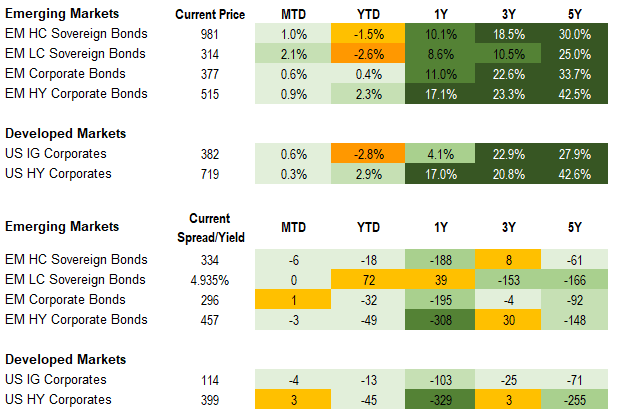
Equities
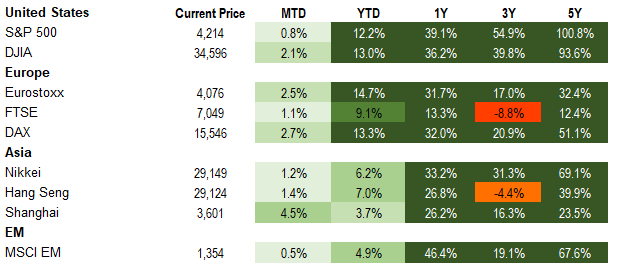
Commodities

Source for data tables: Bloomberg, JPMorgan, Gramercy. EM Fixed Income is represented by the following JPMorgan Indicies: EMBI Global, GBI-EM Global Diversified, CEMBI Broad Diversified and CEMBI Broad High Yield. DM Fixed Income is represented by the JPMorgan JULI Total Return Index and Domestic High Yield Index. Fixed Income, Equity and Commodity data is as of May 28, 2021 (Mid Afternoon).
Emerging Markets Weekly Highlights
Belarus is in the epicenter of market attention after forced landing of EU-bound airplane raises geopolitical risks again
Event: Under the pretext of a bomb threat, last Sunday authorities in Belarus forced a Lithuania-bound Ryanair flight from Greece to land in Minsk and arrested an exiled Belarussian dissident journalist/blogger who was onboard. European and U.S. leaders reacted strongly to the incident involving a commercial flight between two EU member-states, calling it a “state-sponsored hijacking” and “utterly unacceptable”.
Gramercy Commentary: The EU has moved uncharacteristically swiftly to impose new sanctions on Belarus, reflecting a broad political consensus over the incident, and has vowed to progressively ratchet up sanctions pressure against President Lukashenko’s regime. Measures announced thus far have severely limited Belarus’ air connections with most of Europe. Potential further sanctions involving measures against Belarus’ important potash exports and/or gas transit from Russia would carry far more meaningful consequences from an economic perspective. If they were to materialize, such measures would mark a substantial escalation in Western pressure on Lukashenko. However, they would also come with significant costs and would be politically tricky for the EU, given energy dependence for a number of member-states on Russian gas transited through Belarus. We think sanctions on sovereign debt, especially on secondary trading, are a low probability scenario, at least for now. As pressure on and isolation of Belarus from the West is likely to continue, we expect that Minsk will increasingly rely on Russian financial and political support. President Lukashenko is headed for another official visit to Moscow during which he will likely discuss with President Putin new loans to cover some of Belarus’ 2021 financing needs. Domestically, Lukashenko has been increasingly vocal about “constitutional reform”. Although unclear what this process would entail, recent examples from the region point toward a gradual and controlled transition out of power for Lukashenko, which could pave the way to potential elections in 2022-23.
Egypt receives constructive Article IV and final review under its SBA program
Event: The IMF reached a staff-level agreement on the completion of Egypt’s Article IV and final review under its $5.2bn 12-month Stand-By Arrangement. Following board approval, the government will receive its final $1.6bn disbursement under the program. Egyptian bonds continued their month-long rally this week on the back of the largely anticipated news.
Gramercy Commentary: Strong performance on macroeconomic and structural criteria under the program, including better than targeted fiscal and FX reserve outcomes, help anchor confidence for continued economic recovery amid conclusion of the financing arrangement. The Fund commended the authorities for the launch of the National Structural Reform Program (NSRP). The NSRP aims to foster human capital development, improve institutional transparency, and transition to a greener economy, all of which should help to enhance Egypt’s ESG and overall credit profile over the medium-term, if well-defined and deployed effectively with a greater role of the private sector. In the near-term, still elevated debt levels and external financing needs will leave Egyptian bonds prone to volatility particularly in a higher interest rate environment absent continuation of multilateral support and technical assistance.
Peru presidential election outcome uncertainty remains high amid tight polls and Shining Path attack
Event: Polls remain narrow with a 5% point gap between radical leftist and outsider candidate, Pedro Castillo, and a well-known center right candidate, Keiko Fujimori. Castillo has 45% support compared to Fujimori with 40%. Undecided voters remain high at roughly 15% with a tendency for many voters to make decisions just ahead of the election. Meanwhile, a deadly attack this week by the militant group, the Shining Path, further complicates the picture on the margin.
Gramercy Commentary: The still high level of undecided voters combined with the unprecedented aspects of this election amid a pandemic and exacerbated rejection of the political class make the outcome difficult to predict. The Shining Path attack increases the uncertainty. Castillo’s party is accused of having links with the group but has come out condemning the event and expressed solidarity with the victims, while Fujimori’s father led the fight against the organization in the 1990s. While his supporters credited him with defeat, the brutality used to accomplish victory is in part a component of the high rejection rate of Keiko Fujimori today, as well as corruption. It is unclear if and how this event or the final presidential debate on Sunday will materially sway voters. In the event of a Castillo victory, assets are likely to sell-off more materially than after his win in the first round given his seemingly extreme views on the role of the state and mining sector policy, albeit a divided Congress. Lack of clarity on his ultimate cabinet and agenda should provide some cap on weakness in the near term. The comparatively high foreign ownership in the local market combined with domestic pension fund trends pose a higher risk to local assets than hard currency assets, which benefit from a very robust overall sovereign balance sheet. A Fujimori presidency would likely be met with an initial positive market reaction, retracing most of the recent electoral weakness. However, governability risks associated from her high disapproval rating, populist Congressional pressures, and ongoing corruption investigations will likely pose headwinds to Peru’s credit profile and mild volatility for Peruvian assets over the medium-term.
Emerging Markets Technicals
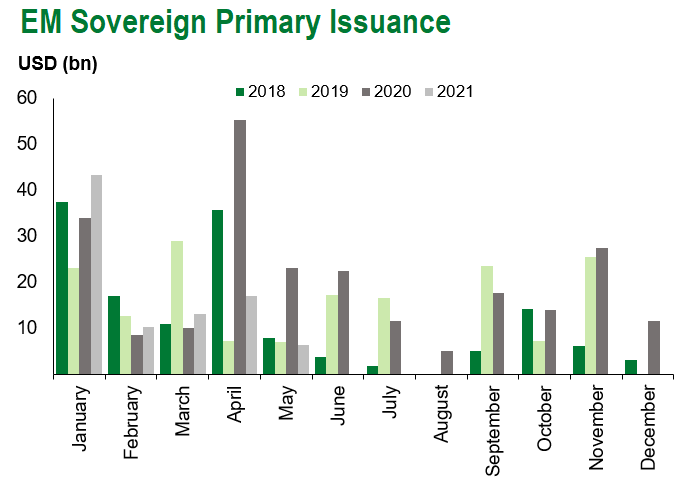
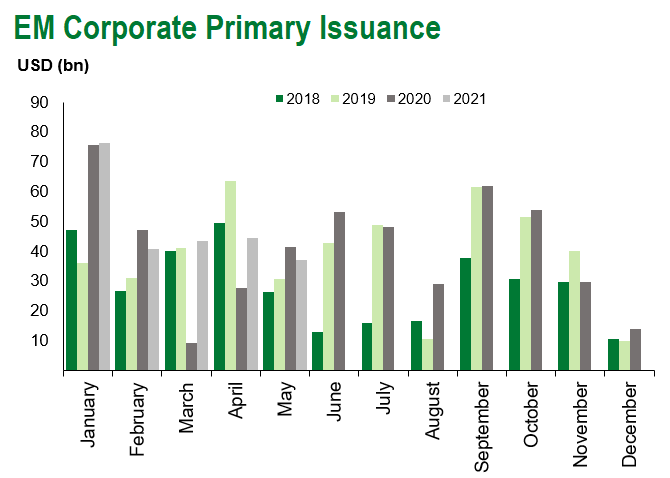
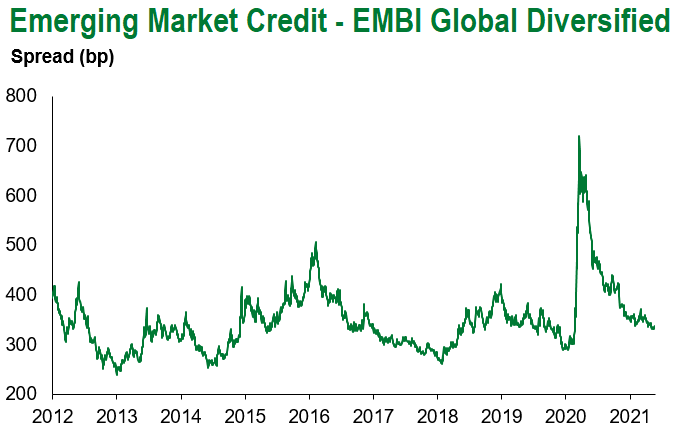
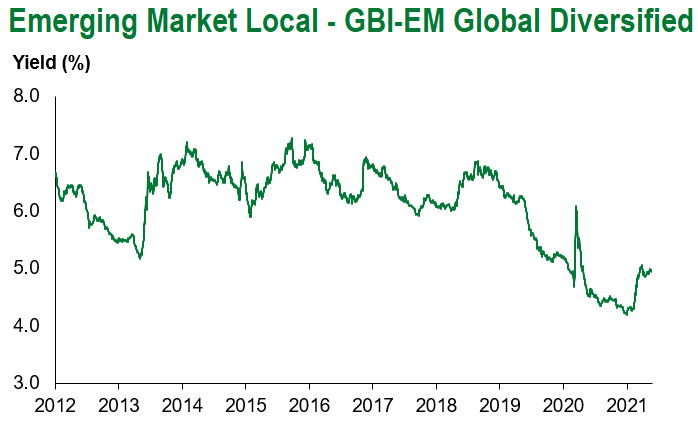
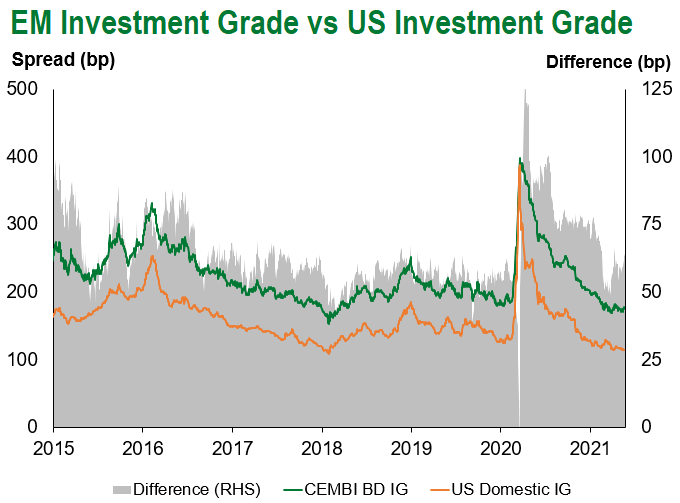
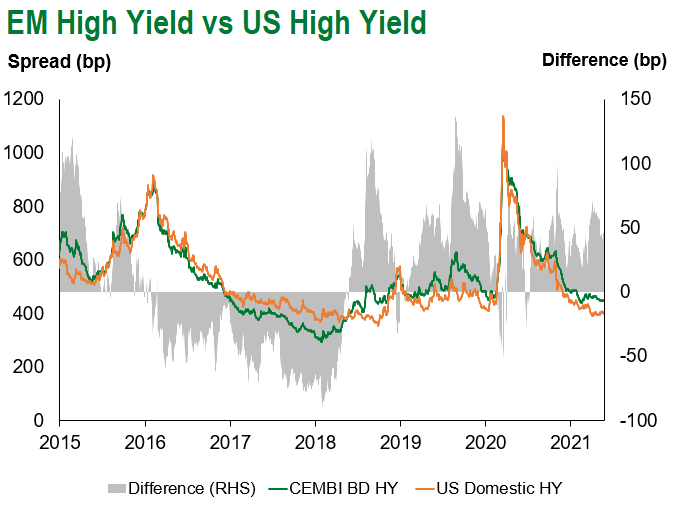
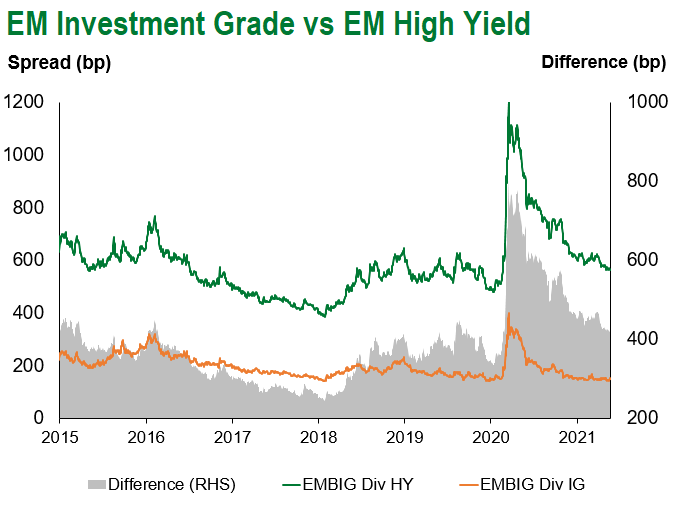
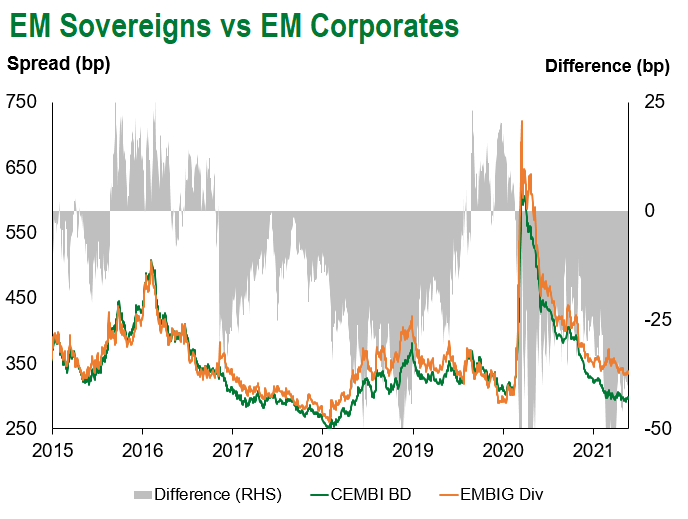
Emerging Markets Flows
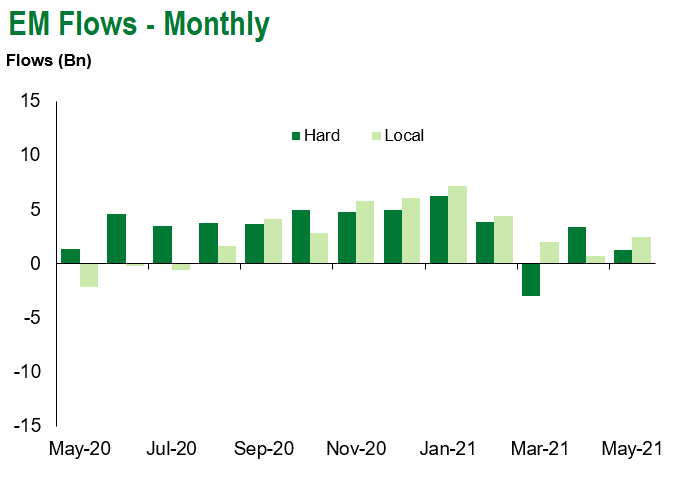
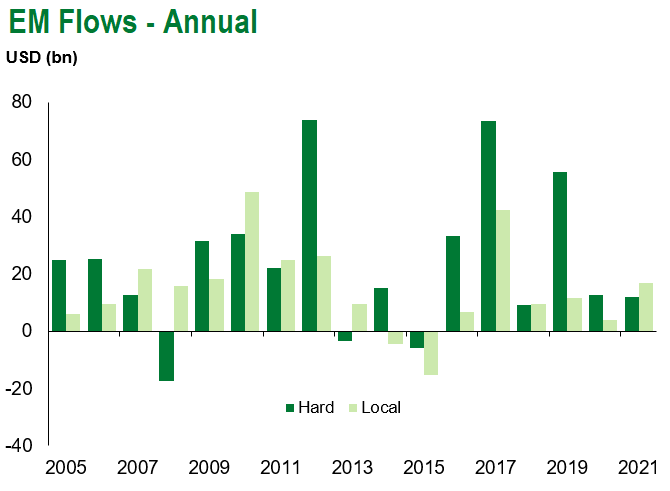
Source for graphs: Bloomberg, JPMorgan, Gramercy. As of May 28, 2021.
COVID Resources
Emerging Markets COVID-19 Case Summary
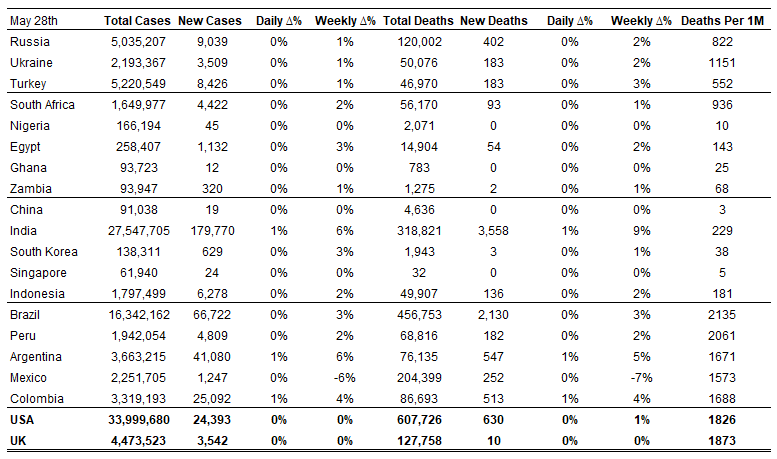
Source: Worldometer as of May 28, 2021.
Additional Crisis Resources:
Johns Hopkins COVID-19 Case Tracker
For questions, please contact:
Kathryn Exum, Senior Vice President, Sovereign Research Analyst, [email protected]
Petar Atanasov, Senior Vice President, Sovereign Research Analyst, [email protected]
Tolu Alamutu, CFA, Senior Vice President, Corporate Research Analyst, [email protected]
James Barry, Vice President, Corporate Research Analyst, [email protected]
This document is for informational purposes only. The information presented is not intended to be relied upon as a forecast, research or investment advice, and is not a recommendation, offer or solicitation to buy or sell any securities or to adopt any investment strategy. Gramercy may have current investment positions in the securities or sovereigns mentioned above. The information and opinions contained in this paper are as of the date of initial publication, derived from proprietary and nonproprietary sources deemed by Gramercy to be reliable, are not necessarily all-inclusive and are not guaranteed as to accuracy. This paper may contain “forward-looking” information that is not purely historical in nature. Such information may include, among other things, projections and forecasts. There is no guarantee that any forecasts made will come to pass. Reliance upon information in this paper is at the sole discretion of the reader. You should not rely on this presentation as the basis upon which to make an investment decision. Investment involves risk. There can be no assurance that investment objectives will be achieved. Investors must be prepared to bear the risk of a total loss of their investment. These risks are often heightened for investments in emerging/developing markets or smaller capital markets. International investing involves risks, including risks related to foreign currency, limited liquidity, less government regulation, and the possibility of substantial volatility due to adverse political, economic or other developments. The information provided herein is neither tax nor legal advice. Investors should speak to their tax professional for specific information regarding their tax situation.